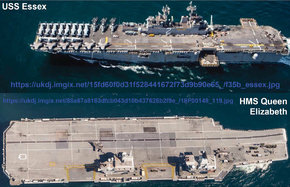Todjaeger
Potstirrer
Realistically, if one of the LHD's were utilized to conduct STOVL fast jet operations, it would mean that the amphibious capabilities would be severely curtailed at best.The reason I raised tat question is because the thread itself seems to argue for the LHD to be configured for fixed wing operations does,nt come back to the needed capabilities for the ADF and those priorities ,if a priority is identified for fixed wing capacity for naval assets then what level of capabilities are required to be meaningful ,
To come back to the Canberra class how would the capacity to perform its designed operations would be lost or affected by the adoption of fixed wing aircraft?
The LHD's were intended to be able to transport, land, and then support a roughly battalion-sized force which could be a combined arms mix of infantry, armour/cavalry, and rotary assets. I would also assume that there were indirect fire elements included in at least some of the potential force mixes, though whether they were 81 mm or 120 mm mortars, and/or M198 or M777 155 mm howitzers I readily admit I do not know/recall.
The embarked landing craft were to be used to bring ashore the vehicles, assuming the LHD was not able to dock and offload at a port, while the planned eight embarked medium helicopters (MRH90's) would be used to bring a significant portion of the personnel to be landed ashore. As a side note, this is one of the major differences between the Canberra-class LHD and Bay-class LSD, and why the LSD lacks permanent aviation facilities as well as having such a lower capacity for embarked troops despite being able to transport more vehicles in some configurations.
At best, if the LHD's were to embark F-35B's, it would reduce the number of vehicles which could be landed. More likely IMO though, is it would both reduce the number of vehicles which could be landed, as well as eliminate the ability of an LHD to land and support troops via helicopter. If the LHD had a significant reduction it's ability to land and support a force using MRH90's, then the LHD would have a much harder and possibly no longer feasible task in conducting amphibious operations.
Stretching things out a bit to take a larger view of the impact on the ADF, trying to establish F-35B operations from the two LHD's would seriously curtail the ADF's ability to use the LHD's to establish an amphibious capability as well as manage some of the HADR responses that Australia has been conducting. It is also possible that trying to raise a STOVL capability would end up eliminating the ability to use the LHD's in amphibious roles. That in turn would effectively leave HMAS Choules as the only amphibious vessel in the RAN/ADF inventory. If the RAN/ADF amphibious fleet were allowed to be reduced to just a single vessel, that would be in spite of lessons that should have been learned from Timor Leste.

